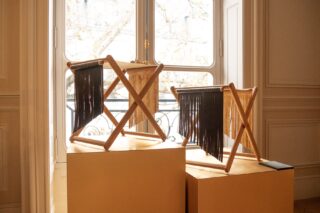IDEO designed LiquidView’s digital windows to transform any room with a spectacular view, notably health and wellness spaces.
In the future, our physical location may not be such a big deal because, with a flick of a switch, augmented reality will take us wherever we want to go. That thought came to mind when I arrived at an office high up in a midtown Manhattan skyscraper and peered through a series of mullioned window frames at sun-dappled rippling waves crashing against a shoreline in Sausalito, California. Every now and then a flock of seagulls would fly by under the golden-hued light late afternoon light, a marked contrast to the gray sky and the rain-splattered Manhattan streetscape I had traversed earlier.
The seashore scene before me was a 24-hour loop shot on a high-definition movie camera by a new media company called LiquidView. According to LiquidView’s CEO, Mitch Braff, his company’s system called the Vista Digital Window, which was designed in conjunction with the global design firm IDEO, is the first high-definition 24-hour loop available.
“We want to make it, so you are there looking at a window and not at a television,” he said, “that’s the goal of this.”
Artificial windows have received a lot of buzz in recent years thanks in part to a controversial and ultimately unsuccessful proposal for a multimillion-dollar windowless dormitory at the University of California, Santa Barbara by the recently deceased Berkshire Hathaway investment legend Charlie Munger who believed that by doing away with real windows in favor of artificial ones, the dormitory he wanted to fund could be designed more efficiently to accommodate more students.
However, the new digital window technology with its 24-hour loop that LiquidView has pioneered certainly represents an advance over previous designs that Braff says depended upon lower definition displays shot with simpler cameras. In contrast, LiquidView’s novel digital window system, which is manufactured and distributed by Leon Speakers, consists of a media player, 4k HDR displays, and a variety of window treatments that screw into the wall. The current pricing runs $25,000 for a one-window display and $100,000 for a three-window panorama. Access to the library of images is $59 a month for one view and access to the complete library of views for $199 a month.
Aside from the novelty factor, Braff says that he believes that his new digital window displays with their 24-hour displays that can be calibrated to align with human circadian rhythms will play a major role in improving the quality of spaces with a dearth of real windows and in doing so enhance people’s sense of wellbeing and productivity. Stanford University psychiatry professor Jamie Zeitzer is currently using LiquidView’s digital window displays to study the effect of light and scenery on people’s psychological states.
“If we look at the dogmatic view on biology, it says that scenery should not matter, that it’s the light,” but Zeitzer says it may be that natural scenery has a more significant influence.
“If you are in an indoor environment everything is static,” he says, “When you are outside everything is moving in a slightly chaotic way.”
One of the big questions Zeitzer’s study is seeking to answer is whether, “instead of being a distractor, all of this subtle movement is a positive is and driving you to a flow state where you are calmer.”
Thus far it is still unclear as to whether LiquidView’s artificial window displays have a significant effect on human health in environments lacking adequate natural windows. However, their Gee Whiz factor certainly cannot be discounted. Currently, the company has a library of four different vistas that includes New York City’s Central Park, and three from California: Sausalito, Rodeo Beach, and Land’s End. But in 2024 LiquidView will be providing a new view every month and they plan to expand their offerings to include different scenic vistas from around the globe.
“You will be able to choose your own views,” says Braff adding, “You could be having a dinner party and boom! You could look at the sunset in five different cities.”











